TPO -> TPOs of Austria
TPOs of Austria
By Tony Goodbody
Travelling post offices made their appearance in Austria in 1850. Now, in 2007, they are just about finished. Since their inception they have used a great many different types and sub types of postmark. It would be quite impossible to show them all here but we have included examples of most of the main types.
First and Second Class TPOs and Mailguards
In Austria there were 1st Class TPOs, 2nd Class TPOs and Mailguards (called Conductor Posts or [later] Gesamtpostkurse).
Some authorities assert that Second Class TPOs and Conductor Posts were one and the same. This does not appear to accord with the facts. Second class TPOs used postmarks with the route number specified, whereas Conductor Posts used postmarks which included not the route number but the train number.
The Early Postmarks
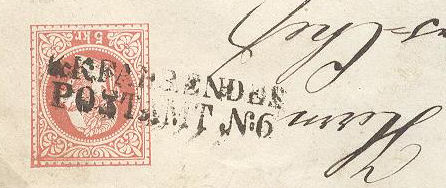 The earliest postmarks were rectangular, undated and inscribed with the words K.K. (KAISERLICH KÖNIGLICH) FAHRENDES POSTAMT:
an approximate translation of which is Imperial Royal Travelling Post Office (figure 1) (Route No.6: PRAG - BODENBACH)
The earliest postmarks were rectangular, undated and inscribed with the words K.K. (KAISERLICH KÖNIGLICH) FAHRENDES POSTAMT:
an approximate translation of which is Imperial Royal Travelling Post Office (figure 1) (Route No.6: PRAG - BODENBACH)
The WIEN - NIMBURG - PRAG route, No. 41, used a straight line mark without the words K.K. etc (Figure 2). The cover shown here was posted at Znaim (Znojmo) on 29th October which information has been added in manuscript. There is unfortunately no year date.
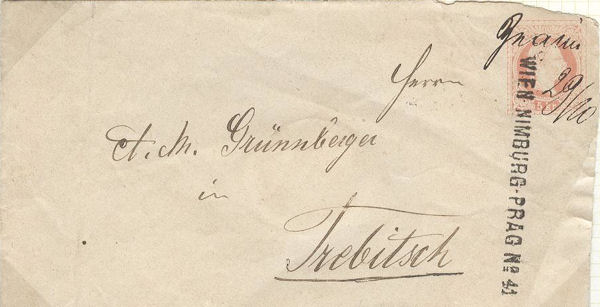
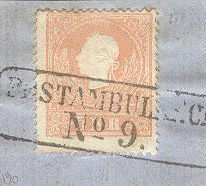
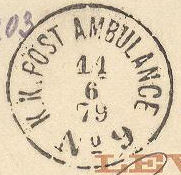
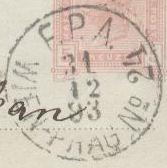 |
||
| Figure 3 | Figure 4 | Figure 5 |
An alternative term for TPO was POSTAMBULANCE (figures 3 & 4: figure 4 being the first dated type). TPO No.9 was the TRIESTE - VIENNA route, used here in 1879. The postmark shown in figure 5 includes the initials F.P.A. (for Fahrendes Post Amt) together with the route (WIEN - PRAG) and the number (24).
Standard Types of Postmark.
By about 1900 the types of postmark had become more or less standardized, with the route round the top and the route number in the centre or at the base (figures 6, 7, 8).
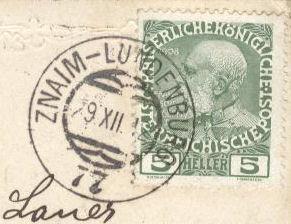
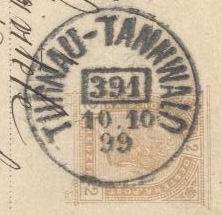
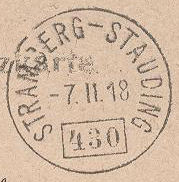 |
||
| Figure 6 | Figure 7 | Figure 8 |
Route numbers 1-200 were assigned to First Class TPOs (figure 6), while route numbers above 200 and up to about 700 were assigned to Second Class TPOs (figures 7 & 8).
20th Century Postmarks
Postmarks used in the 20th Century are usually of the type shown in figs 9 or 10 with the terminal points and route number specified. There are several minor variations.
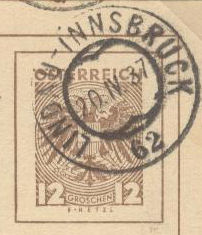
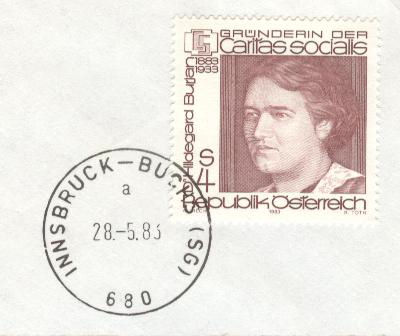
Figure 9 Figure 10
Mail Guards
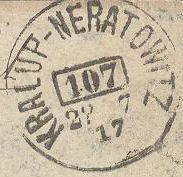 We now hit a problem. The postmark shown in figure 11 (the same type as figure 7) is from a
mailguard and the number, 107, is the train number and not the route number. How can we tell the difference?
The answer is that we can't unless we have more information, but here are some guides.
Numbers over 1000 can be assumed to be train numbers and indicate a mailguard. Alternatively if the postmark is known
with several different numbers within a restricted range, that too probably indicates a mailguard.
The postmark shown in figure 11, for example, is known with the numbers 103, 107, 108 and 112, i.e. two out and two back
indicating a working twice a day.
We now hit a problem. The postmark shown in figure 11 (the same type as figure 7) is from a
mailguard and the number, 107, is the train number and not the route number. How can we tell the difference?
The answer is that we can't unless we have more information, but here are some guides.
Numbers over 1000 can be assumed to be train numbers and indicate a mailguard. Alternatively if the postmark is known
with several different numbers within a restricted range, that too probably indicates a mailguard.
The postmark shown in figure 11, for example, is known with the numbers 103, 107, 108 and 112, i.e. two out and two back
indicating a working twice a day.
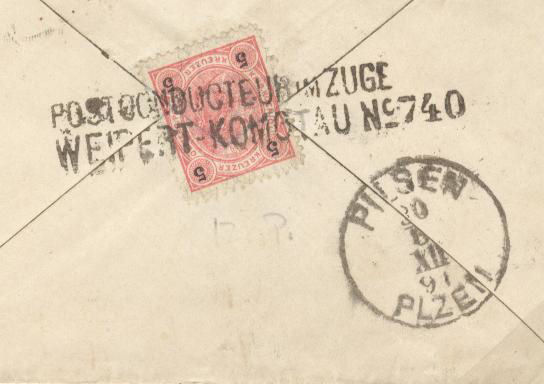
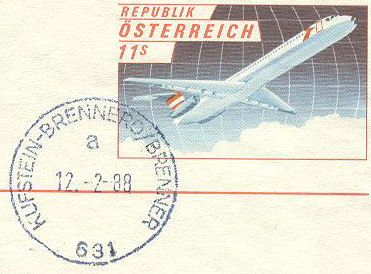 Another type of mailguard postmark is shown in figure 12 reading POSTCONDUCTEUR IM ZUGE/ WEIPERT - KOMOTAU No. 740.
This is known for train numbers 733 - 740 inclusive. A more recent name for mailguard is Gesamtpostkurs as shown in figure 13 (below).
However figure 14 (right) is also a mailguard route (KUFSTEIN - BRENNER), quite indistinguishable from a standard TPO mark.
Another type of mailguard postmark is shown in figure 12 reading POSTCONDUCTEUR IM ZUGE/ WEIPERT - KOMOTAU No. 740.
This is known for train numbers 733 - 740 inclusive. A more recent name for mailguard is Gesamtpostkurs as shown in figure 13 (below).
However figure 14 (right) is also a mailguard route (KUFSTEIN - BRENNER), quite indistinguishable from a standard TPO mark.
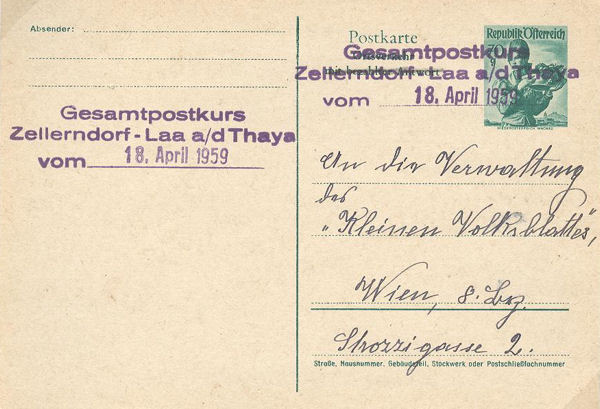
Unusual postmarks
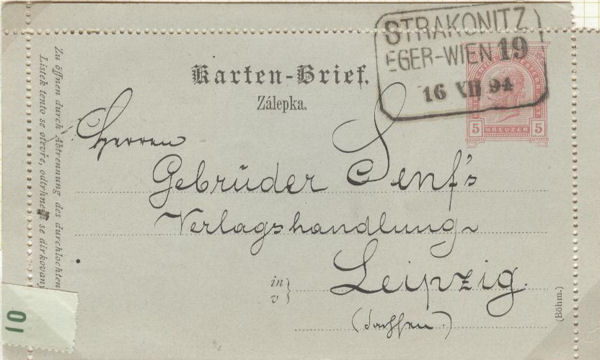
Some routes used peculiar postmarks such as the 1st Class TPO shown in figure 15 which includes the station of posting (Strakonitz). This is from the route EGER - WIEN.
 Another unusual postmark was the one shown in figure 16 for the route TACHAU - PLAN.
This includes the train number: 3155 of the Plan - Tachau Lokalbahn. This is clearly a mailguard duty.
Another unusual postmark was the one shown in figure 16 for the route TACHAU - PLAN.
This includes the train number: 3155 of the Plan - Tachau Lokalbahn. This is clearly a mailguard duty.
Bibliography:
There is a long series of articles in 'Austria' the Journal of the Austrian Stamp Club of Great Britain. Parts 1-8 dealing with the subject up to about 1900 appeared from July 1966 to April 1968. Presumably the series was continued beyond part 8.

